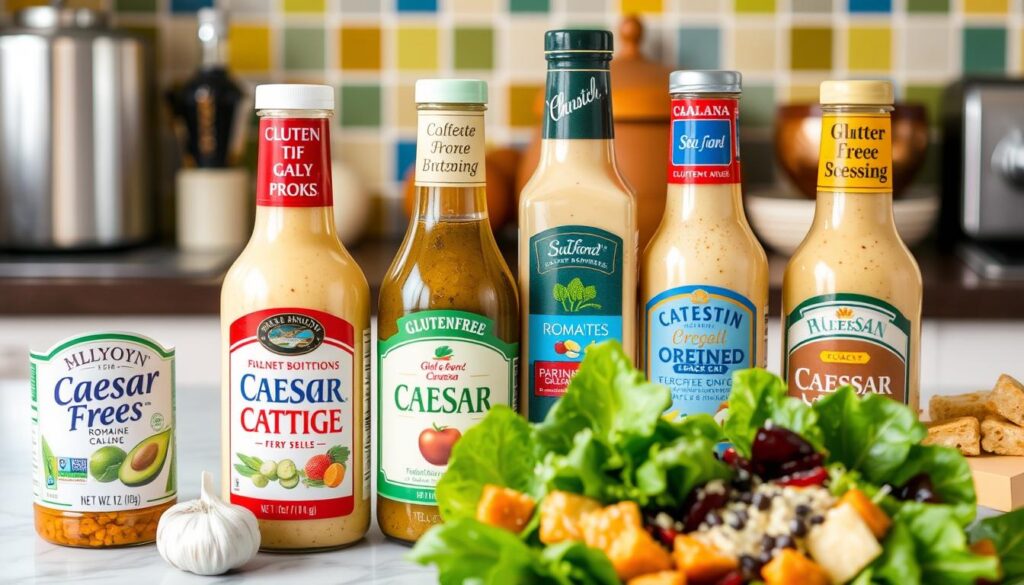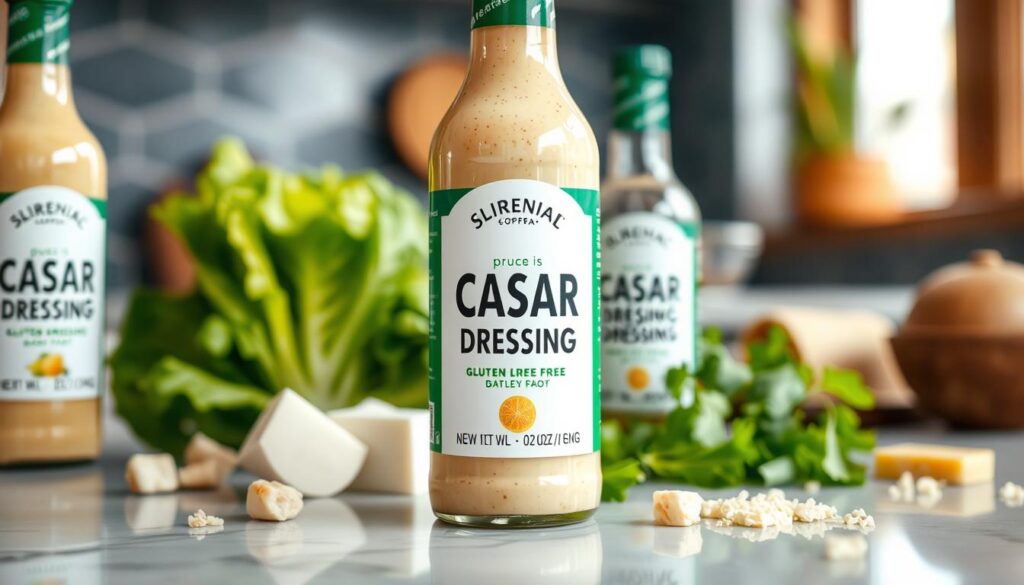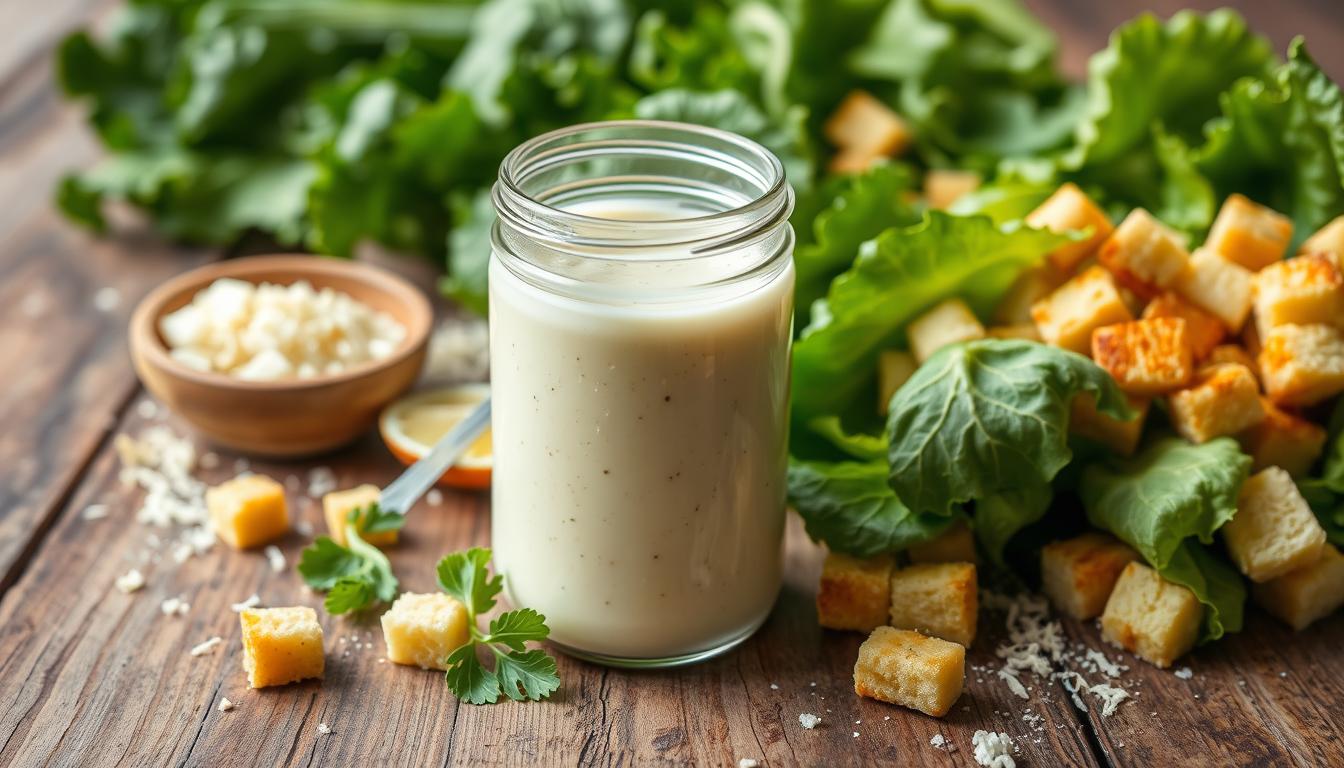If you love Caesar salad but worry about gluten, you’re not alone. This guide will look at Caesar dressing’s ingredients and where gluten might hide. We’ll also share tips for a gluten-free Caesar salad that’s just as tasty.
Key Takeaways
- Caesar dressing often contains gluten-containing ingredients like Worcestershire sauce and modified food starch.
- Proper label reading and understanding hidden sources of gluten are crucial for those with gluten sensitivities or celiac disease.
- Many popular Caesar dressing brands offer gluten-free options, making it easier to find a safe choice.
- Homemade gluten-free Caesar dressing is a simple and delicious alternative, allowing you to control the ingredients.
- Dining out with gluten sensitivity requires careful menu navigation and communication with restaurant staff.
Understanding Caesar Dressing: Traditional Ingredients and Components
Caesar dressing is a famous condiment loved worldwide. Its unique taste comes from a mix of traditional ingredients. Let’s look at the classic Caesar dressing base and the common additives and variations that have come up over time.
Classic Caesar Dressing Base Ingredients
The heart of a traditional Caesar dressing recipe includes:
- Egg yolks, which give a creamy texture
- Lemon juice, adding a tangy, acidic taste
- Olive oil, for a smooth, luxurious feel
- Parmesan cheese, bringing a savory, umami flavor
- Anchovy paste, adding a subtle, salty depth
Common Additives and Variations
Many chefs and home cooks have tried new ingredients to make their own Caesar salad versions. Some common additions and variations include:
- Garlic, for a stronger savory taste
- Dijon mustard, adding a tangy note and helping the dressing mix
- Worcestershire sauce, for more depth and umami flavor
- Mayonnaise, to make the dressing creamier
Historical Background of Caesar Dressing
The story of Caesar dressing starts in the 1920s. It was made by Caesar Cardini, an Italian-American chef in Tijuana, Mexico. Cardini mixed the ingredients together tableside, creating a memorable dining experience.
“Caesar’s dressing was made fresh in front of the customer. It was original, and it was unique.”
– Julia Child, renowned chef and television personality
What Makes a Dressing Gluten Free?
To be gluten-free, a food must have less than 20 parts per million (ppm) of gluten, as the FDA rules. This rule is for all foods, including salad dressings like Caesar. Most Caesar dressing ingredients, like olive oil, lemon juice, and Parmesan cheese, are naturally gluten-free. But, there are hidden gluten sources that can get into the mix.
It’s important to check if a Caesar dressing has gluten-free certification. This certification means the dressing was made in a way that avoids gluten. Without it, even gluten-free ingredients might not be safe for people with gluten issues.
- The FDA gluten standards require less than 20 ppm of gluten for a product to be labeled as gluten-free.
- Naturally gluten-free ingredients in Caesar dressing include olive oil, lemon juice, Parmesan cheese, and garlic.
- Gluten-free certification ensures the manufacturing process is free from cross-contamination risks.
Knowing these gluten-free certification rules helps you choose safe Caesar dressings. This way, you can make sure your dressing is right for your diet.
Hidden Sources of Gluten in Caesar Dressing
Caesar dressing might seem simple, but it can hide gluten. This is a problem for those with gluten sensitivities. Knowing these risks helps people make better choices when they use this dressing.
Worcestershire Sauce Concerns
Worcestershire sauce is often found in Caesar dressing. But, it can have gluten in Worcestershire sauce from malt vinegar, made from barley. People with gluten sensitivities should check the sauce’s labels to make sure it’s gluten-free before using it in their Caesar dressing.
Modified Food Starch Issues
Modified food starch gluten is another gluten source in Caesar dressing. Some brands use it to thicken the dressing. This starch might come from wheat, making the dressing not gluten-free for those who need it.
Cross-Contamination Risks
- Shared equipment contamination is also a worry for Caesar dressing’s gluten-free status.
- Commercial Caesar dressings made in facilities that handle gluten can get contaminated. This means they might have gluten in them.
Those with gluten sensitivities need to watch out for these gluten sources. They should research the ingredients and how the dressing is made before using it.
Popular Brands: Is Caesar Dressing Gluten Free?
Finding gluten-free Caesar dressing brands can be tricky. Some big names like Ken’s, Newman’s Own, and Kraft offer gluten-free options. But, others might have gluten hidden in their ingredients, which is a worry for those who are sensitive.
Ken’s Steakhouse has a gluten-free Caesar dressing that’s popular. Newman’s Own also offers a gluten-free Caesar dressing with high-quality ingredients. However, Kraft’s traditional Caesar dressing has wheat, making it not good for a gluten-free diet.
- Ken’s Steakhouse offers a gluten-free Caesar dressing
- Newman’s Own provides a gluten-free Caesar dressing option
- Kraft’s traditional Caesar dressing may contain wheat-based ingredients
Always check the labels for the “gluten-free” label when buying gluten-free Caesar dressing brands. Some products might use modified food starch or Worcestershire sauce, which can have gluten.

By choosing certified gluten-free Caesar dressing brands, people with gluten sensitivities can enjoy Caesar dressing. They can do this without worrying about their diet.
Making Your Own Gluten-Free Caesar Dressing at Home
Making a tasty homemade gluten-free Caesar dressing is simple. Just a few ingredients and some prep work are needed. You’ll get a DIY Caesar sauce recipe that’s gluten-free and delicious.
Essential Ingredients
To whip up your own gluten-free Caesar dressing, gather these key items:
- Mayonnaise
- Parmesan cheese
- Garlic
- Lemon juice
- Dijon mustard
- Anchovies (optional, for authentic flavor)
- Salt and pepper to taste
Step-by-Step Recipe
Here’s how to make your homemade gluten-free Caesar dressing:
- In a medium bowl, mix the mayonnaise, Parmesan cheese, garlic, lemon juice, and Dijon mustard.
- If you’re using anchovies, chop them finely and add to the mix.
- Whisk everything together until it’s smooth and well combined.
- Season with salt and pepper to taste.
- Chill the homemade gluten-free Caesar dressing for at least 30 minutes. This lets the flavors blend.
Storage Tips
To keep your homemade gluten-free Caesar dressing fresh, store it in an airtight container. Keep it in the fridge for up to 5 days. It might thicken in the fridge, so stir it well before using.
Reading Labels: How to Identify Gluten in Caesar Dressing
Looking through food labels can be tough, especially for those with gluten issues. For Caesar dressing, it’s key to check the ingredients list. This helps make sure you’re eating what you need to.
Let’s look at the hidden gluten ingredients to watch out for. We’ll also talk about how to understand allergen statements.
Decoding Food Labels
To find gluten-free Caesar dressing, start by reading the ingredient list carefully. Look for wheat, barley, rye, and their by-products. Also, “modified food starch” or “natural flavors” might mean there’s hidden gluten.
The allergen statement is another important part. It tells you if the product has wheat or other big allergens. If it says “contains wheat” or “may contain gluten,” it’s best to skip that Caesar dressing.
| Common Gluten-Containing Ingredients | Potential Gluten-Free Alternatives |
|---|---|
| Wheat, barley, rye, and their derivatives | Corn, rice, tapioca, or potato-based ingredients |
| Modified food starch | Unmodified, gluten-free starches |
| Natural flavors | Clearly labeled “gluten-free” natural flavors |
By carefully decoding food labels and knowing what ingredients mean, you can find gluten-free Caesar dressing. This way, you can eat what you need without worry.

“Always read the label, even on products you’ve used before. Manufacturers can change their formulas at any time.” – Celiac Disease Foundation
Safe Alternatives and Substitutions
If you’re looking for gluten-free options, there are many choices. You can find both store-bought and homemade alternatives. They offer the creamy flavors you love without gluten worries.
Commercial Gluten-Free Options
Many salad dressing brands now offer gluten-free Caesar dressings. Here are some popular ones:
- Primal Kitchen Avocado Oil Caesar Dressing
- Annie’s Organic Gluten-Free Caesar Dressing
- Tessemae’s Lemon Garlic Caesar Dressing
- Walden Farms Calorie-Free Caesar Dressing
You can find these gluten-free Caesar dressings at most grocery stores. This makes it easy to enjoy the classic taste without gluten.
Alternative Dressing Choices
For more gluten-free salad dressing options, try vinaigrette and creamy dressings. Here are some great choices:
- Balsamic Vinaigrette: A mix of olive oil, balsamic vinegar, and seasonings.
- Lemon Vinaigrette: Made with fresh lemon juice, olive oil, and herbs.
- Ranch Dressing: A creamy, dairy-based dressing that can be gluten-free.
- Green Goddess Dressing: A mix of herbs, yogurt, and olive oil.
These gluten-free salad dressings are a tasty and safe choice for those on a gluten-free diet.
Tips for Dining Out with Gluten Sensitivity
Dining out with gluten sensitivity can be tough, but it’s not impossible. With a few simple tips, you can have a worry-free meal. This way, you can make sure your dietary needs are met.
First, talk clearly with the restaurant staff about your dietary needs. When you order, ask about the ingredients and how dishes are made. This includes restaurant gluten-free options. It helps spot gluten sources and avoid cross-contact during cooking.
- Be specific about your needs, such as avoiding any wheat, barley, or rye products.
- Request that your food be prepared on a clean, dedicated surface to minimize the risk of cross-contact prevention.
- Inquire about the use of shared fryers or utensils that could lead to cross-contact prevention.
Also, pick dishes that are naturally gluten-free. Think grilled or baked proteins, fresh salads, and steamed veggies. Stay away from fried foods, sauces, or gravies, as they might have hidden gluten. If unsure, communicating dietary needs with the staff can make your meal safe and enjoyable.
| Tip | Description |
|---|---|
| Communicate Clearly | Be specific about your gluten sensitivity and ask detailed questions about the ingredients and preparation methods. |
| Choose Wisely | Opt for naturally gluten-free dishes, and avoid fried foods, sauces, and gravies that may contain hidden sources of gluten. |
| Ensure Cross-Contact Prevention | Request that your food be prepared on a clean, dedicated surface to minimize the risk of cross-contact. |
By following these tips and communicating dietary needs with the restaurant staff, you can enjoy a safe and satisfying meal. Remember, your health and comfort are most important when eating out.
Conclusion
Exploring whether Caesar dressing is gluten-free has been a journey. We looked at the traditional ingredients and possible hidden gluten sources. We also checked out popular brands.
While some Caesar dressings are gluten-free, it’s key to read labels well. If you’re gluten sensitive, choose certified gluten-free products.
It’s important to make smart choices about what you eat. Knowing about gluten-free Caesar dressing lets you enjoy it safely. Always look for gluten-free certification and watch out for cross-contamination.
With the right knowledge, you can enjoy Caesar dressing while sticking to a gluten-free diet. Stay informed, make good choices, and enjoy the tasty world of gluten-free living.
